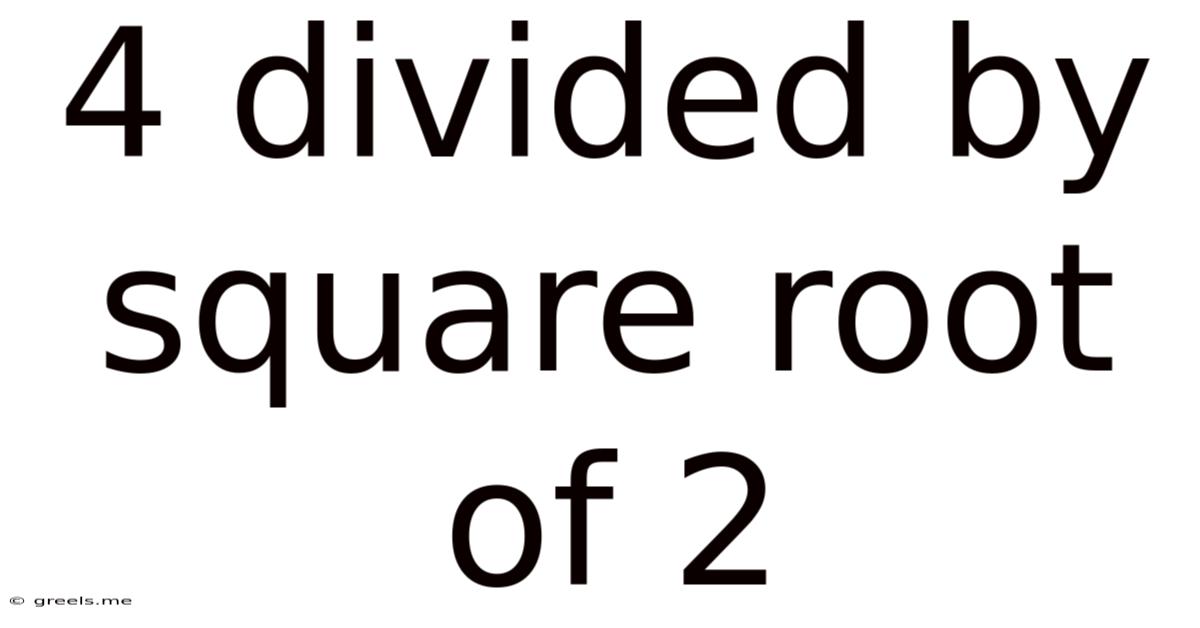4 Divided By Square Root Of 2
Greels
May 04, 2025 · 5 min read

Table of Contents
4 Divided by the Square Root of 2: A Deep Dive into Simplification and Rationalization
The seemingly simple mathematical expression "4 divided by the square root of 2" (4/√2) presents a fascinating opportunity to explore fundamental concepts in algebra and number theory. While a calculator will readily provide a decimal approximation, understanding the process of simplifying this expression reveals deeper mathematical principles and enhances problem-solving skills. This article will delve into the various methods of simplifying 4/√2, explaining the rationale behind each step and highlighting the importance of rationalizing the denominator. We will also explore the broader implications of this seemingly basic calculation, touching upon its relevance in geometry, trigonometry, and beyond.
Understanding the Problem: 4/√2
The core of the problem lies in the presence of an irrational number in the denominator: √2. An irrational number is a number that cannot be expressed as a simple fraction (a ratio of two integers). While we can obtain an approximate decimal value for √2 (approximately 1.414), leaving it in the denominator is generally considered poor mathematical form. The preferred method involves rationalizing the denominator, a process that eliminates irrational numbers from the denominator, resulting in a simpler and often more useful expression.
Method 1: Rationalizing the Denominator by Multiplying by √2/√2
The most common and straightforward method of simplifying 4/√2 involves multiplying both the numerator and the denominator by √2. This is permissible because multiplying by √2/√2 is equivalent to multiplying by 1, which doesn't change the value of the expression.
Steps:
-
Multiply the numerator and denominator by √2:
(4/√2) * (√2/√2)
-
Simplify the numerator:
4 * √2 = 4√2
-
Simplify the denominator:
√2 * √2 = 2
-
Combine the simplified numerator and denominator:
(4√2)/2
-
Further simplification:
Notice that both the numerator and the denominator are divisible by 2. Therefore, we can simplify further:
(4√2)/2 = 2√2
Therefore, 4/√2 simplifies to 2√2. This is the most concise and elegant representation of the solution.
Method 2: Using the Properties of Square Roots
This method leverages the properties of square roots to directly simplify the expression. We can rewrite 4 as 2*2, and then apply the square root properties.
Steps:
-
Rewrite 4 as 2*2:
(2*2)/√2
-
Separate the fraction:
(2/√2) * 2
-
Simplify the first fraction:
(2/√2) = (√2*√2)/√2 = √2
-
Combine the simplified fraction and the remaining 2:
√2 * 2 = 2√2
This method demonstrates an alternative approach, highlighting the flexibility in manipulating square roots. It again arrives at the simplified form of 2√2.
Why Rationalize the Denominator?
While both 4/√2 and 2√2 represent the same numerical value, the latter is preferred for several reasons:
-
Simplicity and Clarity: 2√2 is a more concise and easily understandable representation. It avoids the cumbersome fraction with an irrational denominator.
-
Accuracy in Calculations: When performing further calculations involving this expression, having a rationalized denominator avoids potential rounding errors that can arise from using an approximate value for √2.
-
Standard Mathematical Practice: Rationalizing the denominator is a standard procedure in mathematics, making it easier for others to understand and verify your work.
-
Avoidance of Ambiguity: Having a rational denominator avoids potential misinterpretations of the expression.
Application in Geometry and Trigonometry
This seemingly simple calculation finds practical applications in various fields, particularly in geometry and trigonometry. Consider a right-angled isosceles triangle with legs of length 2. Using the Pythagorean theorem, the hypotenuse would have a length of √(2² + 2²) = √8 = 2√2. The ratio of the hypotenuse to one leg would be (2√2)/2 = √2. Similarly, many trigonometric calculations involve simplifying expressions with irrational numbers, where rationalizing the denominator becomes crucial for accurate calculations and clear representations.
Beyond the Basics: Exploring Related Concepts
The simplification of 4/√2 provides a springboard to explore more advanced mathematical concepts:
-
Conjugates: The concept of conjugates is closely related to rationalizing denominators involving square roots. The conjugate of a binomial expression (a + b√c) is (a - b√c). Multiplying an expression by its conjugate is a powerful tool for simplifying expressions containing radicals.
-
Complex Numbers: While not directly relevant to this particular problem, the process of rationalizing denominators extends to complex numbers, where the denominator might contain imaginary units (i). The techniques are analogous, involving multiplying by the complex conjugate.
-
Approximations and Numerical Methods: While rationalizing the denominator is preferred for exact representation, it's also valuable to understand how to obtain numerical approximations. Various numerical methods exist for calculating square roots to a desired degree of accuracy.
Conclusion: The Power of Simplification
The seemingly simple task of simplifying 4/√2 underscores the importance of mathematical rigor and the elegance of simplification. The process of rationalizing the denominator isn't just about aesthetics; it's about achieving a clearer, more efficient, and less error-prone representation of a mathematical expression. This fundamental skill lays the groundwork for tackling more complex problems in various mathematical disciplines and reinforces a deeper understanding of fundamental algebraic principles. The ability to manipulate and simplify expressions involving irrational numbers is a critical skill that extends far beyond the classroom and finds application in various scientific and engineering fields. By mastering this technique, students gain a more comprehensive understanding of the mathematical landscape and develop a heightened appreciation for mathematical precision.
Latest Posts
Related Post
Thank you for visiting our website which covers about 4 Divided By Square Root Of 2 . We hope the information provided has been useful to you. Feel free to contact us if you have any questions or need further assistance. See you next time and don't miss to bookmark.